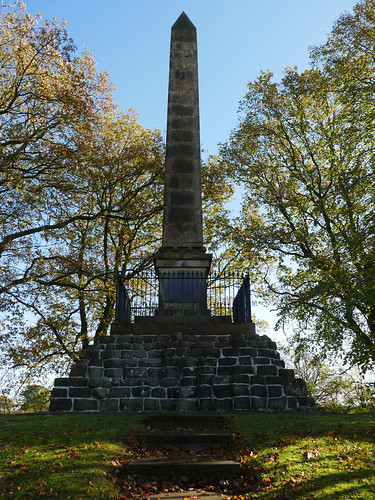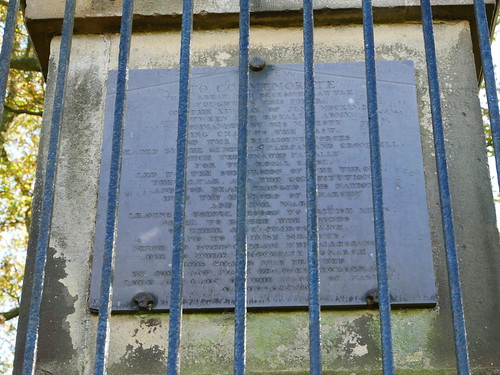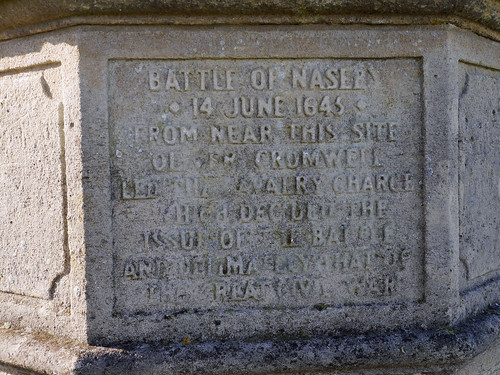TO COMMEMORATE THAT GREAT AND DECISIVE BATTLE FOUGHT IN THIS FIELD .
ON THE DAY OF XIV DAY OF JUNE MDCXLV,
COMMANDED BY HIS MAJESTY
KING CHARLES THE FIRST,
AND THE PARLIAMENT FORCES
HE ADED BY THE GENERALS’ FAIRFAX AND CROMWELL.
WHICH TERMINATED FATALLY
FOR THE ROYAL CAUSE, LED TO THE THR ONE,
THE ALTAR, AND THE CONSTITUTION,
AND FOR YEARS PLUNGED THIS NATION
INTO THE HORRORS OF ANARCHY
AND CIVIL WAR:
LEAVING A USEFUL LESSON TO BRITISH KINGS:
NEVER TO EXCEED THE BOUNDS
OF THEIR JUST PREROGATIVE,
AND TO BRITISH SUBJECTS.
NEVER TO SWERVE FROM THE ALLEGIENCE
DUE TO THEIR LEGITIMATE MONARCH.
THIS PILLAR WAS ERECTED
BY JOHN AND MARY FRANCES FITZGERALD.
LORD AND LADY OF THE MANOR OF NASEBY
AD MDCCCXXIII
The decisive battle of the English Civil War was fought in the fields of Naseby, Sulby, Sibbertoft and Clipstone parishes on Saturday 14 June, 1645. The Parliamentarian New Model Army, under the command of Sir Thomas Fairfax, defeated the Royalist army, commanded by King Charles I and Prince Rupert of the Rhine.
Patrols clashed on the evening of 13 June in Naseby village. Early on Saturday 14 June Fairfax marche the New Model Army north from Guilsborough towards Naseby to meet here, at Naseby windmill. The wheeled transport, the baggage and artillery trains, had to stay on the primitive road to avoid getting stuck in the mud. The foot and horse would have chosen their own routes. The regiments were then organised into ‘battalia’, their fighting formation. No one knew if they were going into battle or if they were to continue their pursuit of the Royalist army through Market Harborough and beyond. Would King Charles stand and fight?
By 8.00am King Charles and Rupert had moved the royal army to a ridge between East Farndon and Little Oxendon. From there this position cannot be seen. Similarly the view north from the windmill is limited by the rising ground, so Fairfax and his commander of horse, Oliver Cromwell, had to ride to the edge of the steep hill overlooking Clipston to look for their enemies. **
Both sides wished to fight and Fairfax ordered his army to a position on the ridge to the south of this place. Rupert saw the movement and brought the Royalist to Dust Hill, across the valley to the north.
This area was mostly open ground, but contained by an ancient boundary hedge around Sulby to the west and a rabbit warren (on today’s Lodge Hill) and boggy ground to the east. Lieutenant General of Horse Oliver Cromwell put dragoons behind Sulby Hedges. Their musket fire caused the royalist cavalry on the western flank to charge, forcing many of parliament’s horses to flee. The Royalist foot attacked and almost broke Fairfax’s line but it stubbornly resisted. Cromwells trouper routed the horse opposing them and fell on the left flank of the royalist foot. Despite Rupert’s Bluecoat Regiment ’standing like a wall of brass’ on the slope just to the west of the road to the north, Fairfax’s counter-attacks succeeded in driving the royalists back. Part of the royalist army went on fighting, all the way they had come that morning, in a battle reaching a climax at Wadborough Hill
*From a signboard next to the Windmill Obelisk
**From a signboard next to Cromwell’s position on the day of the battle













Very rich pasture there as a result.
It does well not to think about that too much.
totally unfamiliar topic you brought to me dear Cherie ,this is magnificent field which witnessed the defeat of king charles by new army .
We have several of these battlefields in our country where kings and their armies have fought with one another.
Great shots! I spent ages tracking down various places associated with the battle and need to go back, really. Too much to see, not enough time!
We didn’t have enough time either. There is a plaque in Market Harborough next to the church so don’t miss that out if you go back again.
Naseby sounds like an ancient town!
Is there a market cross there?
We didn’t stop in Naseby though perhaps we should have done. It does have a market cross:
http://mapio.net/pic/p-87588391/